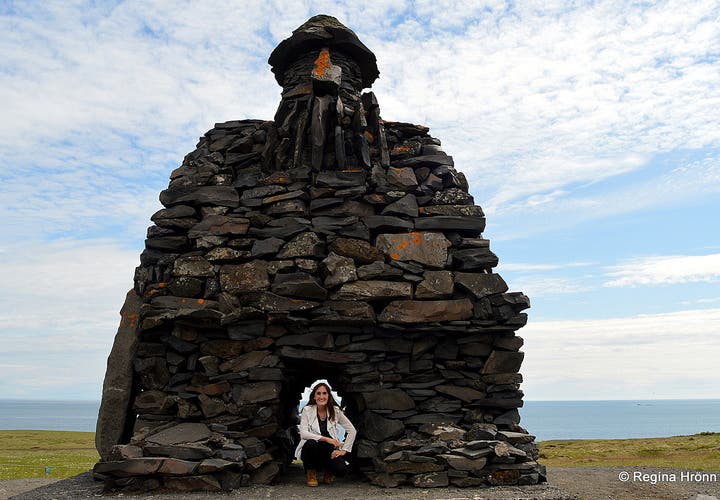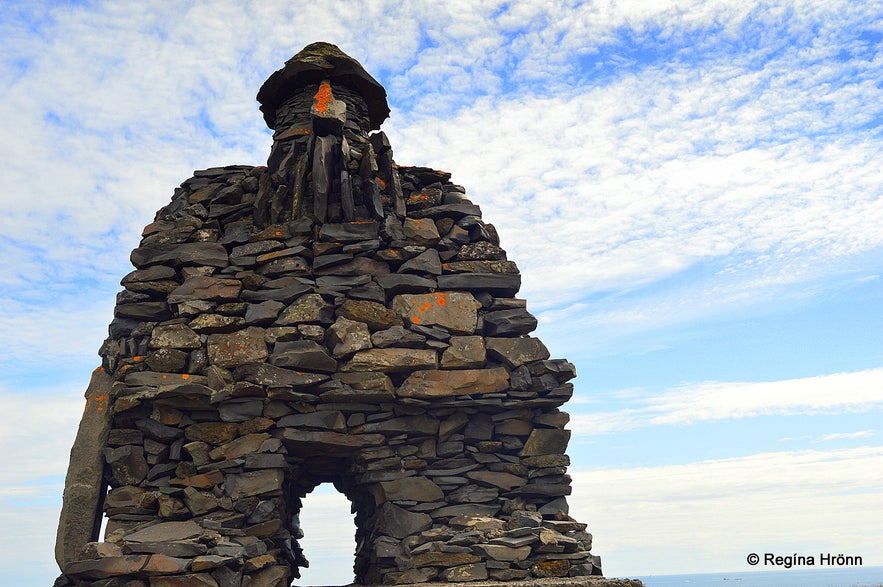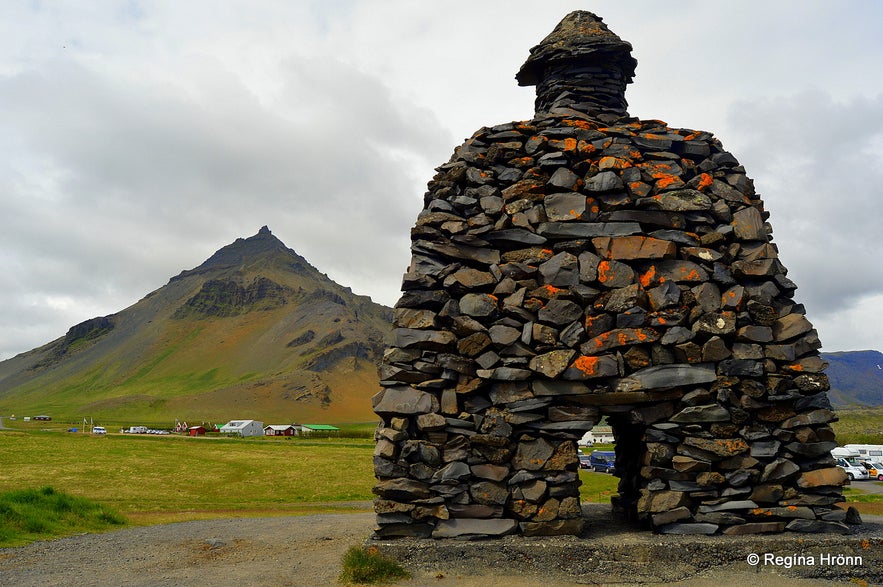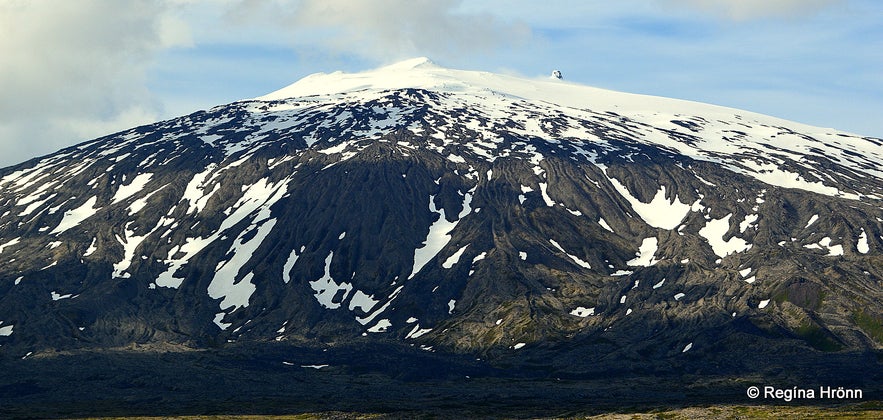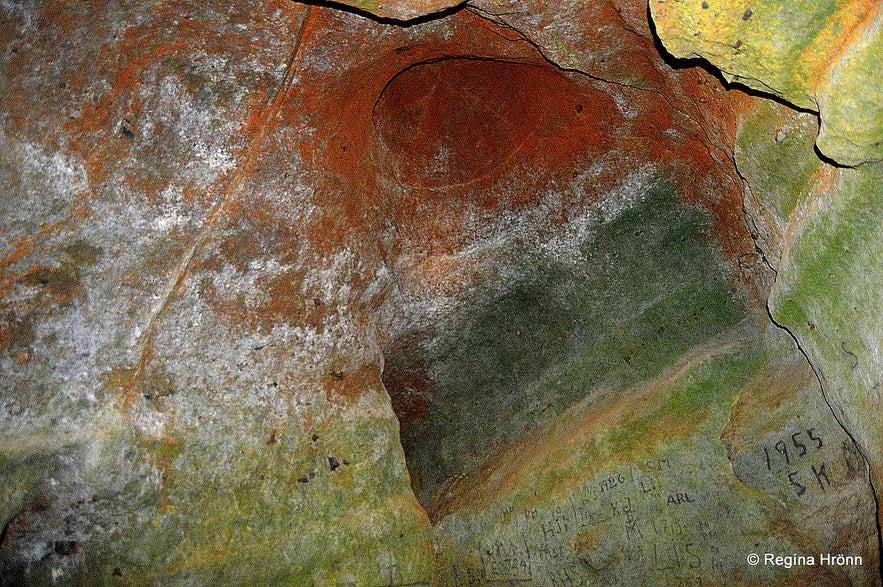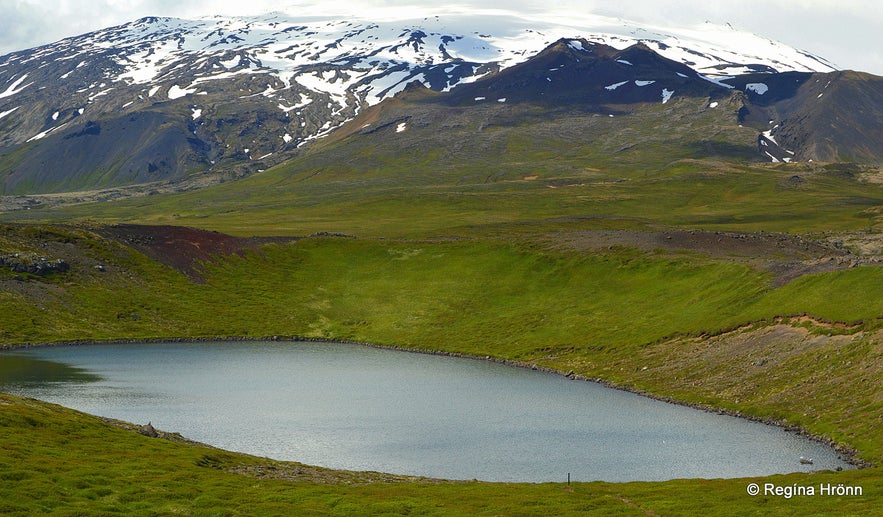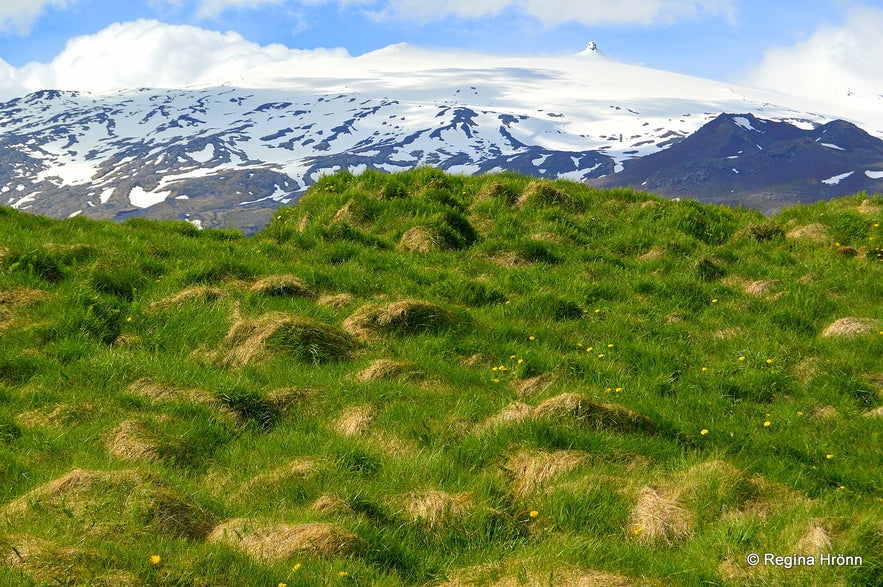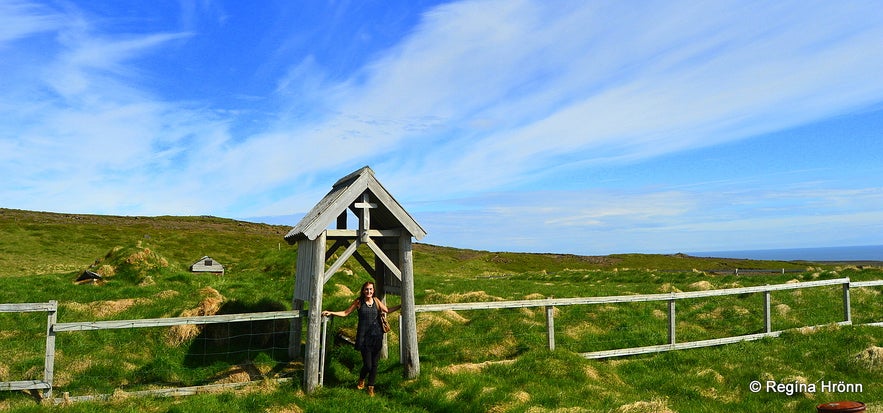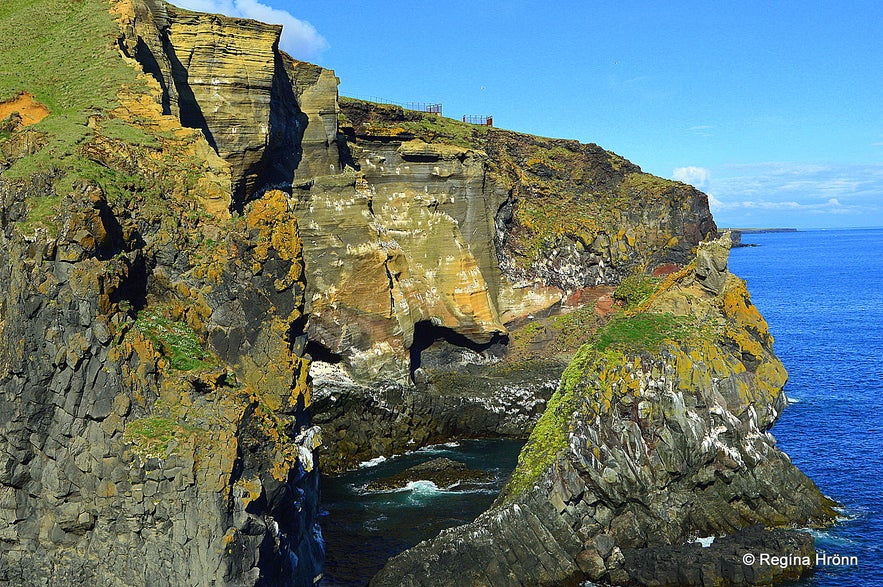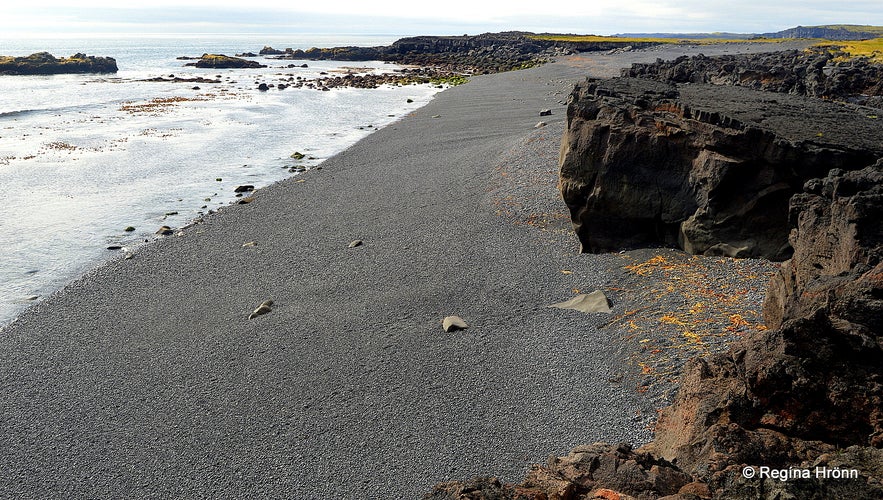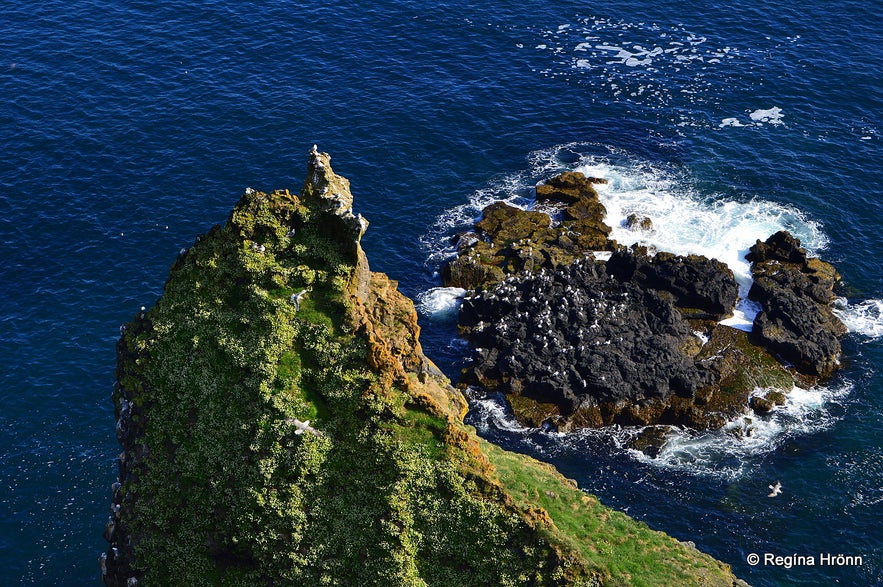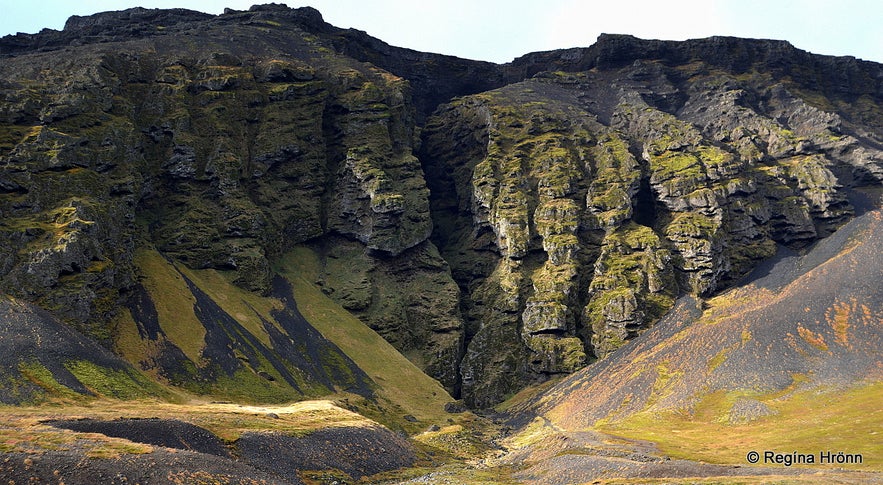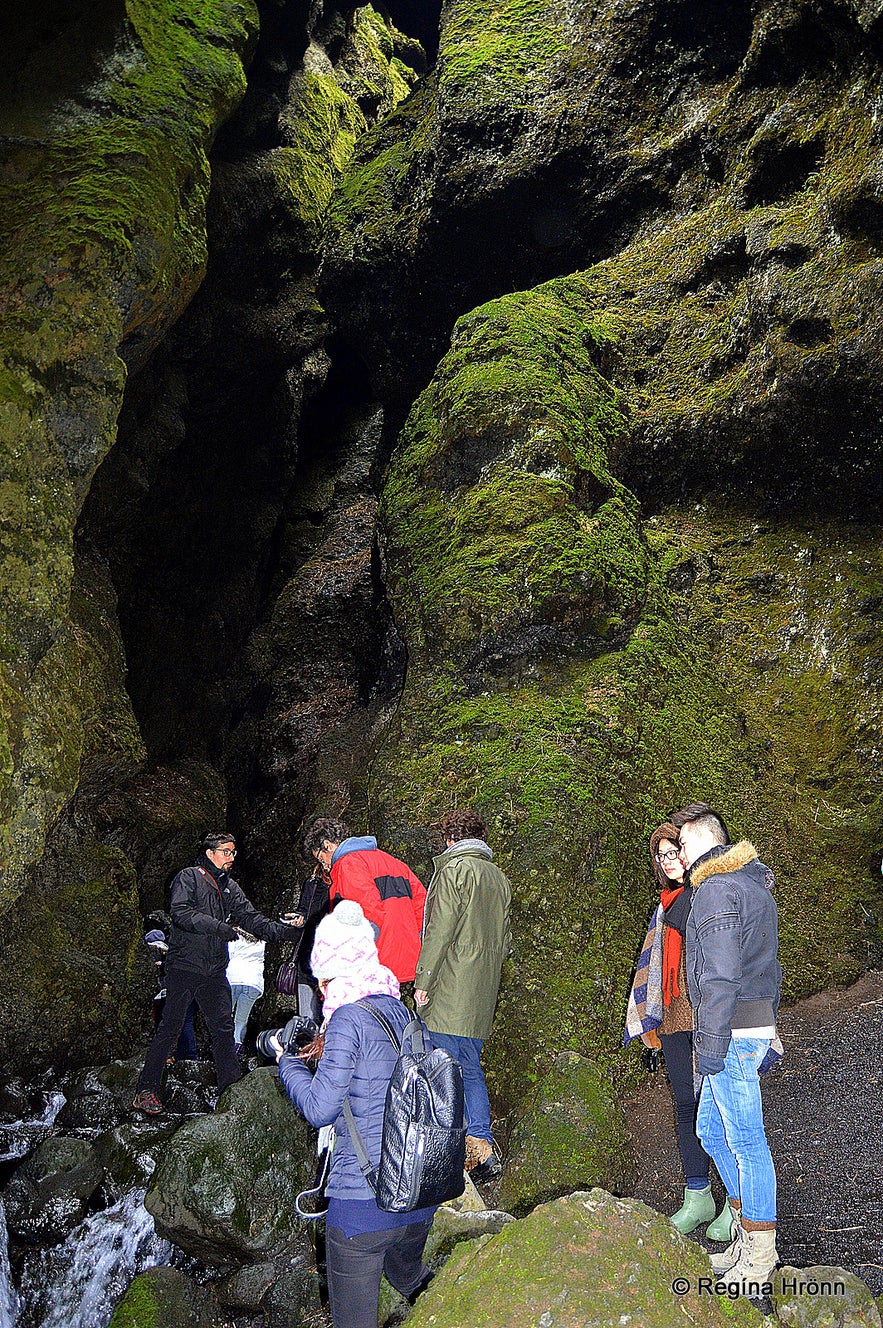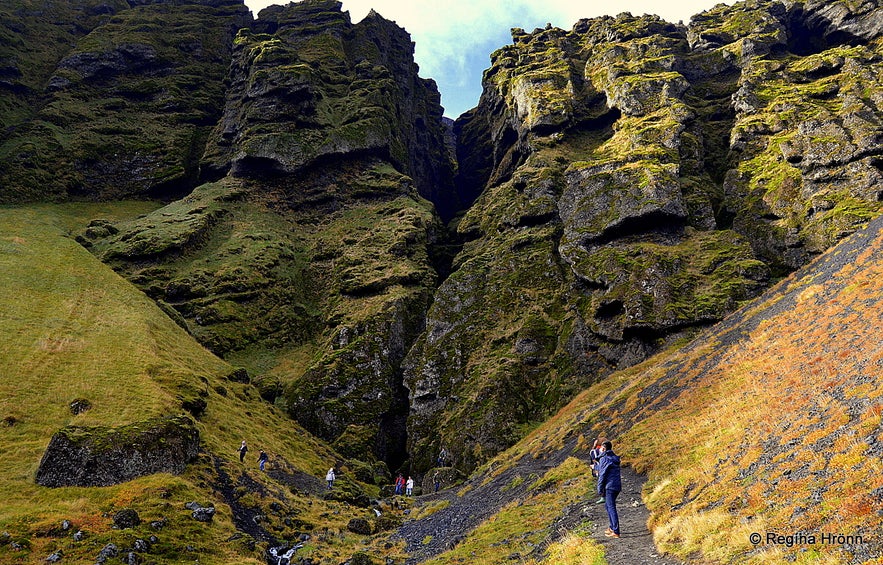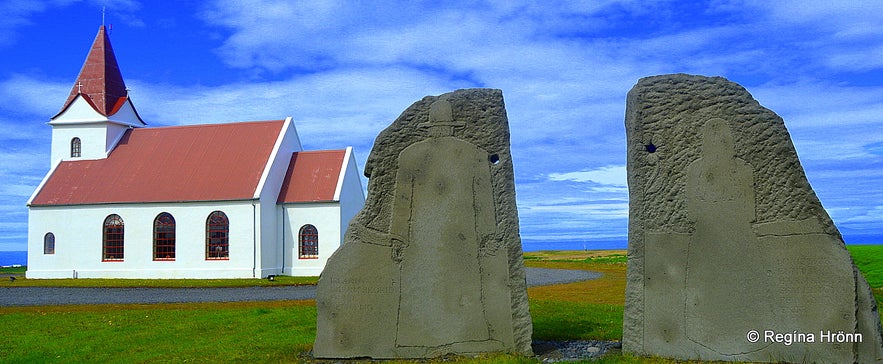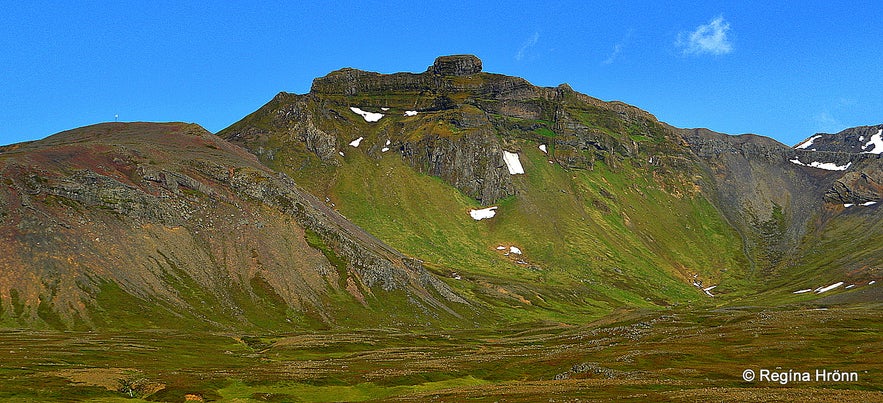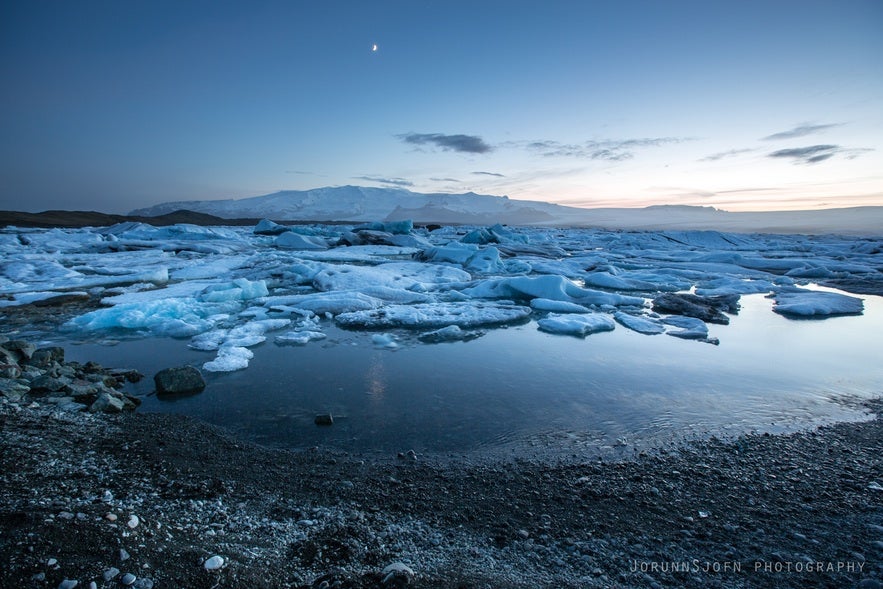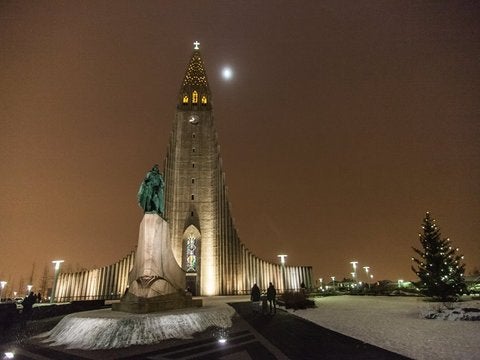In my 5-part series of travel-blogs about the Magical Snæfellsnes peninsula in West Iceland, I often mentioned the half troll-half man Bárður Snæfellsás - the Protector of the Snæfellsnes peninsula.
Bárður was according to Bárðar Saga Snæfellsáss the settler of this area, half a troll, and half a man, his father was half a titan, but his mother was human.
Top photo: a close-up of the statue of Bárður at Arnarstapi
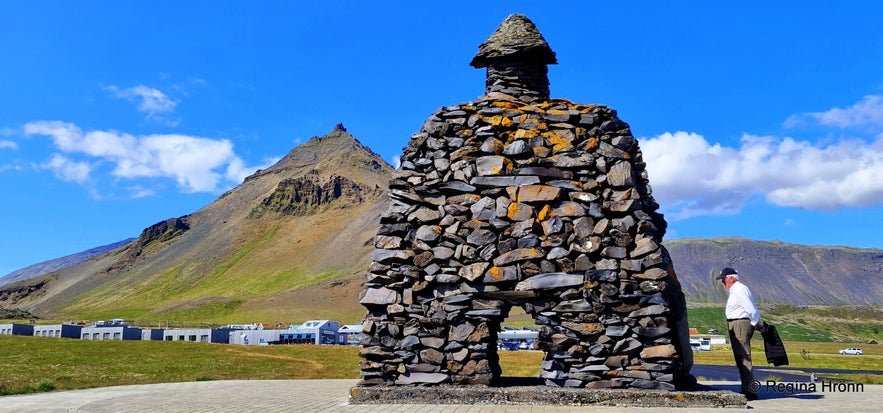 Bárður Snæfellsás at Arnarstapi
Bárður Snæfellsás at Arnarstapi
Bárður came to Iceland in the 9th century and gave the peninsula its name, Snjófellsnes peninsula, but both words "snær" and "snjór" mean snow in Icelandic.
To give you a better insight into his interesting story I decided to dedicate a special travel-blog to Bárður Snæfellsás and show you the places on the south side of the peninsula that are mentioned in Bárðar Saga Snæfellsáss, which is the Icelandic Saga on Bárður.
The statue of Bárður Snæfellsás
You will see this huge stone structure of Bárður Snæfellsás at Arnarstapi, made by Ragnar Kjartansson sculptor, who also made the statue at the Fishermen's Garden and Maritime Museum in Hellissandur.
I visited an exhibition of a private collection of some of the small statues made by Ragnar Kjartansson.
There on display was the prototype for the big statue of Bárður Snæfellsás. It is so small.
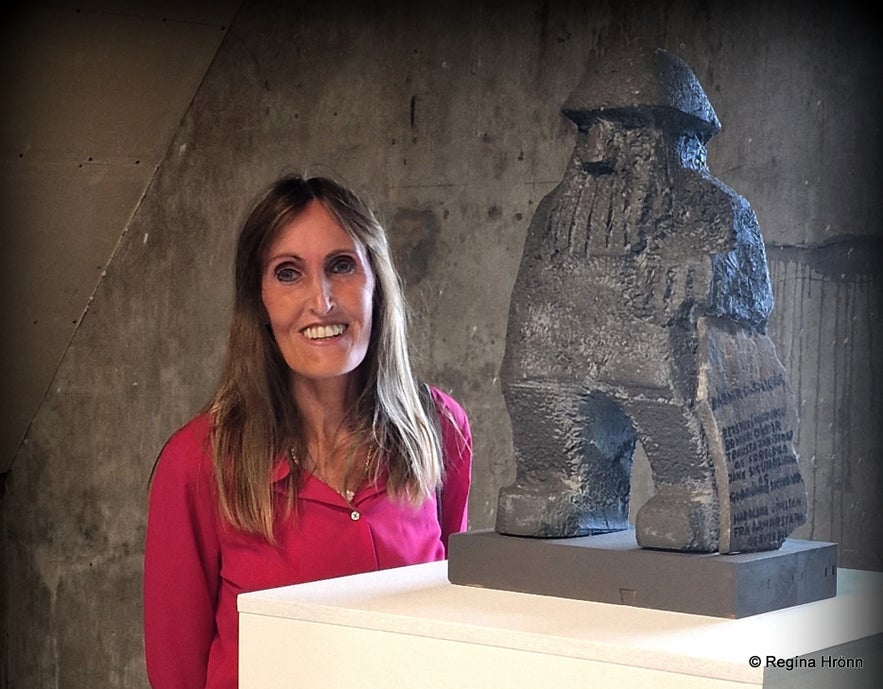 The prototype is so small and so cute - the light from the window behind was not favourable
The prototype is so small and so cute - the light from the window behind was not favourable
Now to tell you a little bit about this huge man. Bárður's father was King Dumbur, who was half a Titan - but Titans are said to be kinder and larger than other people - and half a giant.
They were not like the Icelandic trolls, but kind, strong people with good business sense - I must confess though that I am no expert on titans and trolls.
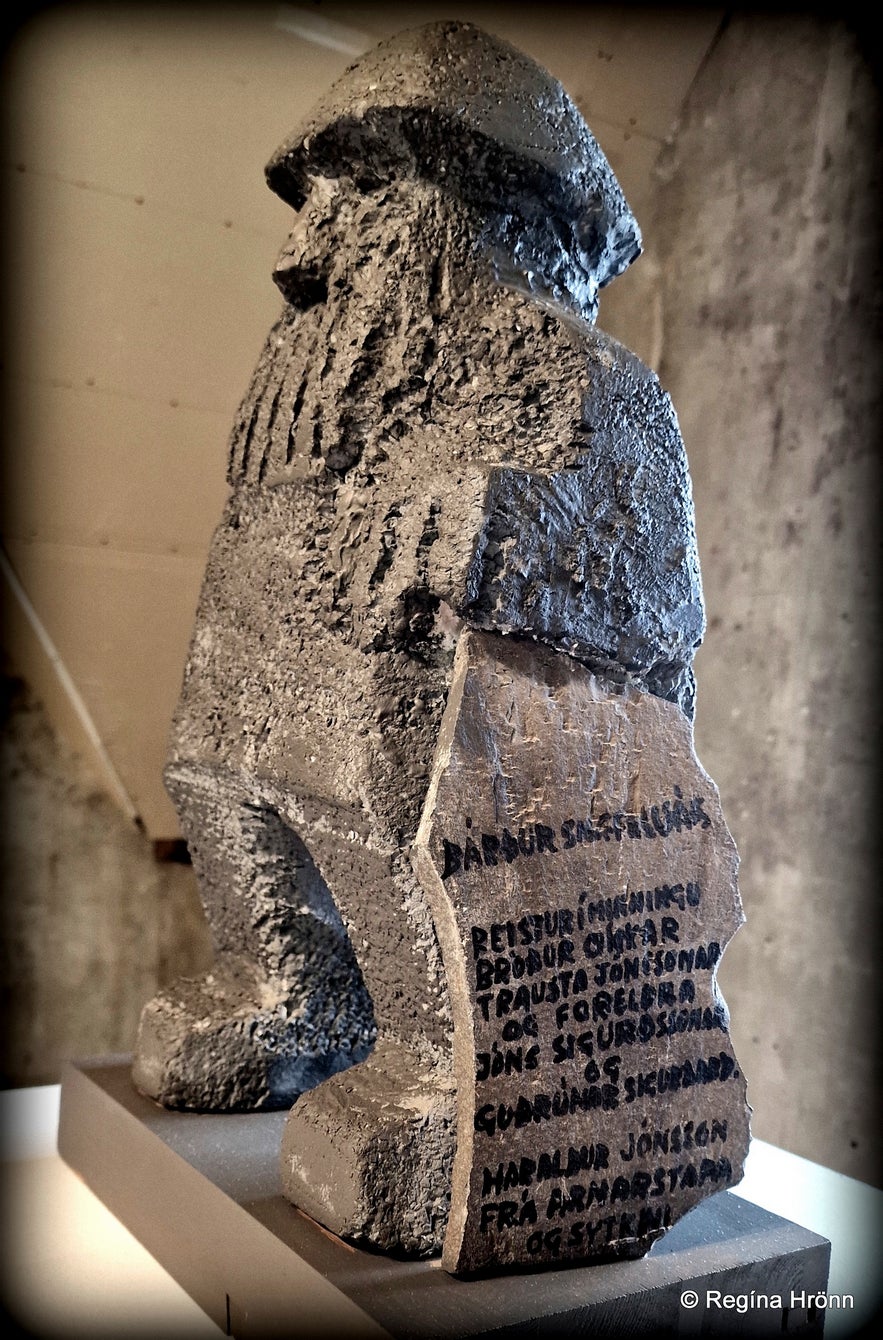 The prototype for Bárður Snæfellsás by Ragnar Kjartansson
The prototype for Bárður Snæfellsás by Ragnar Kjartansson
Dumbur was hard to deal with though if something was not to his liking. Dumbur needed a wife and kidnapped a beautiful human woman, Mjöll, who was also one of the largest of women.
These people were to become the parents of Bárður Snæfellsás - a titan and a human.
Bárður (born around 900) was their oldest child, named after his grandfather, Bárður risi or Bárður the Titan. Bárður grew up to become one of the most handsome of men.
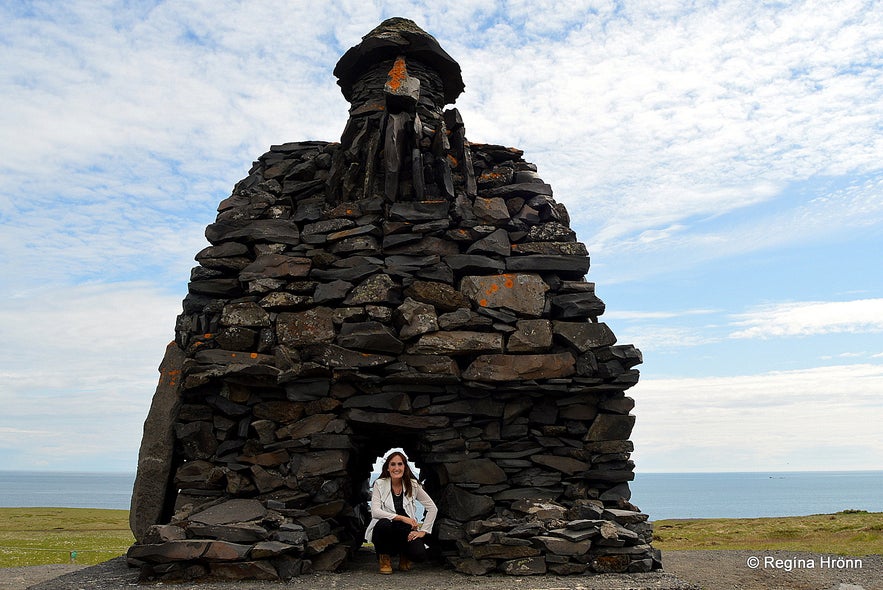
With Bárður at Arnarstapi
He looked like his beautiful mother, Mjöll, and it is said in the Saga of Bárður that the most beautiful white snow got its name from the skin tone of his mother, Mjöll.
In Icelandic, we still use this word, mjöll, for beautiful white snow falling in still weather.
That kind of snow is the most beautiful of all, in my opinion.
Bárður Snæfellsás and Mt. Stapafell
Shortly after there was a dissident between the Titans and King Dumbur and as to not put his son Bárður in any danger, Dumbur moved south to Norway to Mt. Dofrafjöll.
There in the mountains ruled Dofri, who was a giant (bergbúi). Dofri became a good friend of the family and took care of Bárður, who was by now 10 years old.
Dofri taught Bárður all kinds of sports and sorcery at which Bárður became efficient.
Mt. Stapafell and Bárður Snæfellsás
Dofri had a daughter called Flaumgerður, but her mother, who was human, had died. Flaumgerður was the biggest of women, a bold woman but not fascinatingly beautiful.
Bárður and Flaumgerður got married when Bárður was only 13 years old. For the next 5 years, they lived in a cave in the mountains with Dofri.
One night Bárður had the most extraordinary dream about the coming of the Norwegian King Olav Haraldsson. After the dream, Bárður and Flaumgerður moved away from Dofri to Hálogaland in the northern part of Norway. 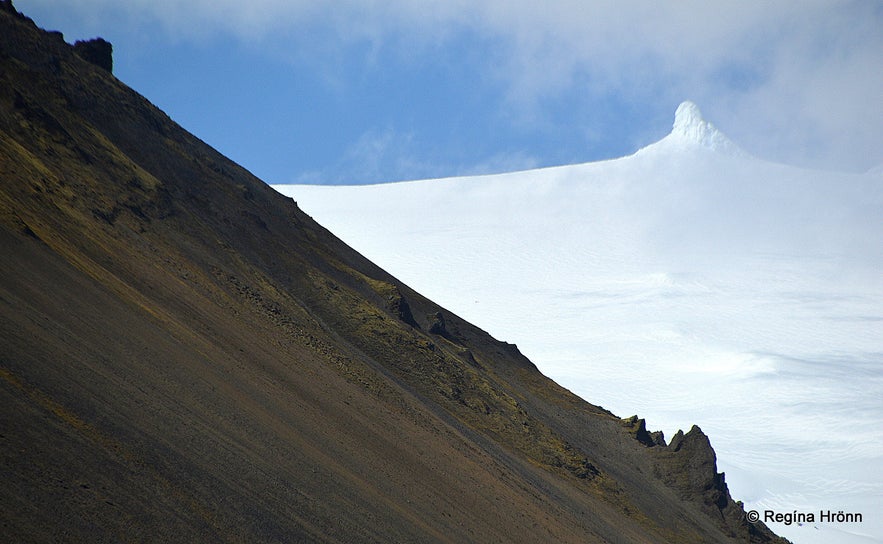
Mt. Stapafell and Snæfellsjökull glacier
Flaumgerður had given birth to their 3 daughters, Helga, Þórdís, and Guðrún. After having spent one winter at Hálogaland Flaumgerður died, which caused great grief to Bárður.
Bárður needed a wife, so he found another woman, Herþrúður Hrólfsdóttir, and they had 6 daughters: Ragnhildur, Flaumgerður, Þóra, Þórhildur, Geirríður, and Mjöll.
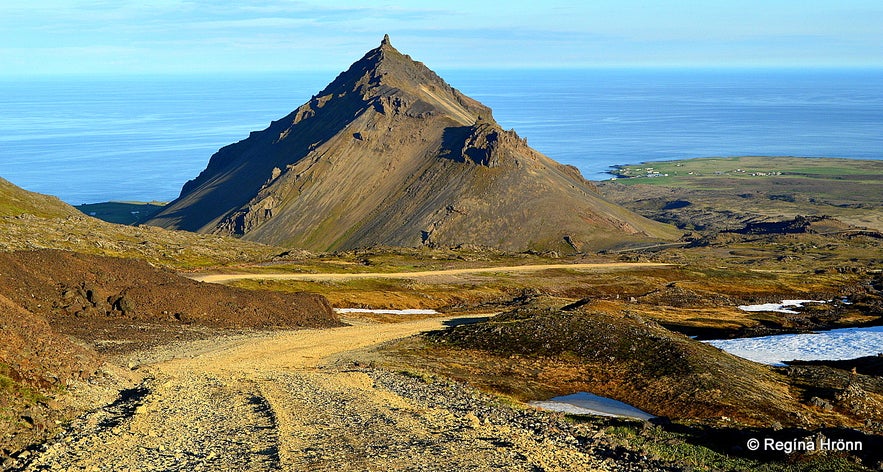 Mt. Stapafell and Arnarstapi are close to the settlement of Bárður Snæfellsás
Mt. Stapafell and Arnarstapi are close to the settlement of Bárður Snæfellsás
Now, back to Bárður's parents. The Titans were still waging war against their king Dumbur under the leadership of Harðverkur, and they ended up killing Dumbur.
Mjöll, the mother of Bárður, remarried and became the wife of the giant Rauðfeldur the Strong and had a son by him, named Þorkell, who was black and strong and mighty.
Mjöll died and Þorkell married Eygerður and went to live close to his half-brother Bárður in Hálogaland. They lived in a fjord called Skjálfti or Tremor.
 There are many beautiful locations in the southern part of Snæfellsnes
There are many beautiful locations in the southern part of Snæfellsnes
Bárður and Þorkell revenged Dumbur and killed Harðverkur and 30 other titans who were with him. There was a new king in Norway, King Harald, who ordered everybody to pay him taxes.
Bárður was not keen on doing so and left Norway to try settlement in Iceland, as so many of our settlers did.
Accompanying Bárður Dumbsson (Snæfellsás) was Bárður Heyangursson (who is my ancestor 30 generations back) who also wanted to try settlement in Iceland.
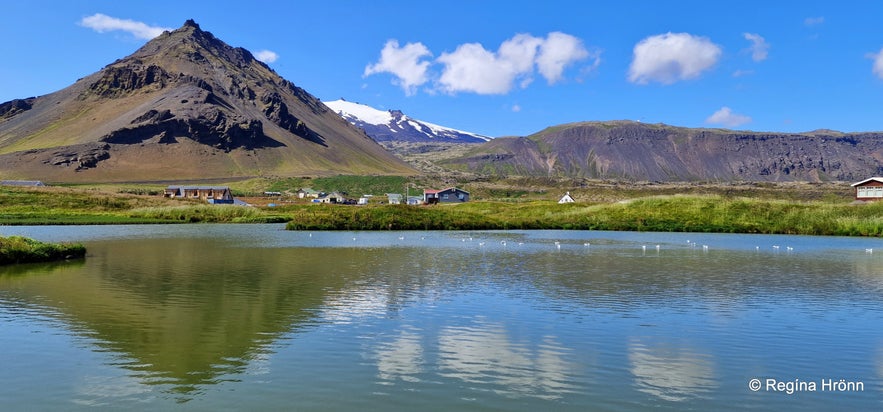 Mt. Stapafell and Snæfellsjökull glacier
Mt. Stapafell and Snæfellsjökull glacier
Bárður Dumbsson sailed on one ship with more than 30 men and Bárður Heyangursson sailed on another ship with the same amount of men.
Herþrúður and all of Bárður's 9 daughters accompanied him to Iceland. And Þorkell Rauðfeldsson the half-brother of Bárður was with them as well.
Plus many other people, some of which are mentioned by name in the Saga, and some even in great detail as is the case with the strange appearance of Bárður's cousin, Þorkell skinnvefja.
Dritvík cove
Dritvík cove - Bárðarskip and Bárðartrúss
The sea voyage of Bárður Dumbsson and Bárður Heyangursson was a rough one and lasted for 50 days. Then they finally saw the white Snæfellsnesjökull glacier towering over the peninsula.
They now decided on parting ways and Bárður Heyangursson sailed to the west and north and settled in Bárðardalur valley, by the end of that valley you will find the extraordinary beautiful waterfall Aldeyjarfoss. Bárður Heyangursson didn't live for long up north as he decided that the south was a better place to live.
He moved to Fljótshverfi in the south and settled at Gnúpar and got the name Gnúpa-Bárður. The notorious volcano Bárðarbunga is named after Gnúpa-Bárður. Bárðarbunga, Iceland's largest volcanic system, lies under the ice cap of Europe's largest glacier, Vatnajökull.
Many people confuse those two Bárðurs and think that the volcano Bárðarbunga is named after Bárður Snæfellsás.
Tröllakirkja - the Troll Church at Dritvík
Bárður Dumbsson, on the other hand, came ashore in Djúpalón and Dritvík cove on the south side of the Snæfellsnes peninsula. Right in front of us in the photo above below the name of the chapter, you will see several pitch-black lava rocks, one of which is called Bárðarskip or the Ship of Bárður, and to the right of it on the beach is Bárðartrúss or the Baggage of Bárður.
According to the Saga of Bárður Snæfellsás, Bárður and his men worshipped their pagan gods for luck when they came ashore in Djúpalón.
In my photo above you will see the pitch-black lava rock called Tröllakirkja or the Church of the Trolls.
Snæfellsjökull glacier
Bárður was the one who gave the name to the Snæfellsnes peninsula when he saw the snow and ice on the Snæfellsjökull glacier, which towers over this part of the peninsula - see my photo above.
Sönghellir - the Singing Cave
Colourful Sönghellir cave
Bárður went on an exploration of the area with his men and found a big cave. Bárður and his men decided to stay in this cave while they were building the farm at Laugarbrekka where Bárður settled.
The cave seemed to answer them back everything they said with an echo or the language of the dwarfs; so Bárður named the cave Sönghellir or the Singing Cave.
There are several caves in Iceland named Sönghellir, but the Sönghellir cave on the Snæfellsnes peninsula is believed to be the first cave in Iceland with this name.
Checking out the markings in Sönghellir cave
There are fantastic acoustics in this cave and it is great fun visiting it and singing a song.
I video-recorded my husband while he was singing in Sönghellir cave, but will keep it for my private collection ;)
After Bárður and his men had settled at Laugarbrekka all the major decisions they made together for the rest of Bárður's life were made here in this cave, Sönghellir.
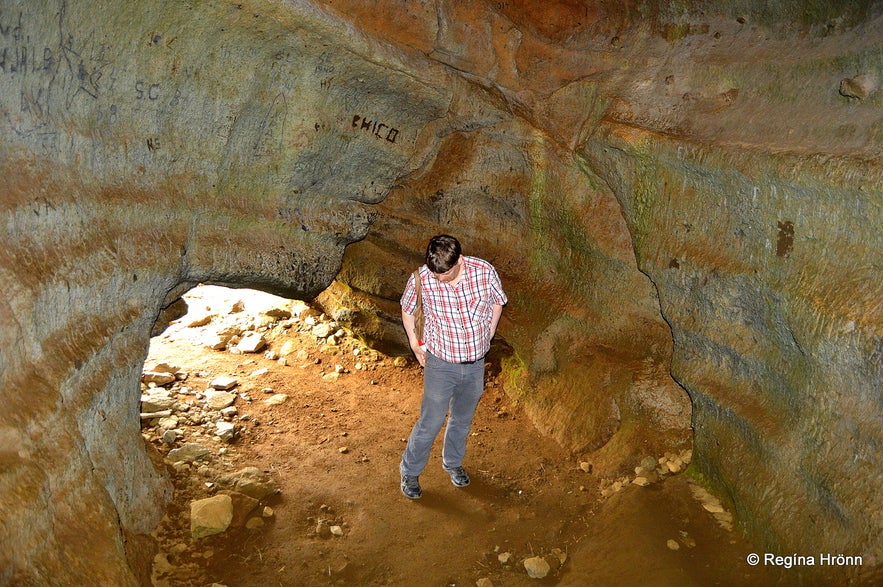 See how small the entrance is
See how small the entrance is
Sönghellir is a well-known cave and much visited by us locals. It is not that easy to find though as there are several caves in this location and the entrance to the cave is narrow.
There are beautiful colours inside the cave, but a bit difficult to take photos as the opening to the cave is so small that there is almost complete darkness in the cave.
Marking in Sönghellir cave
The cave is made of tuff and there are so many markings and names on the walls of the cave, some of which are really old for Iceland, or around 500 years old.
Many people have used the Sönghellir cave as a shelter through the centuries and left their markings, initials, and dates inside the cave to let others know that they had to seek shelter in this cave.
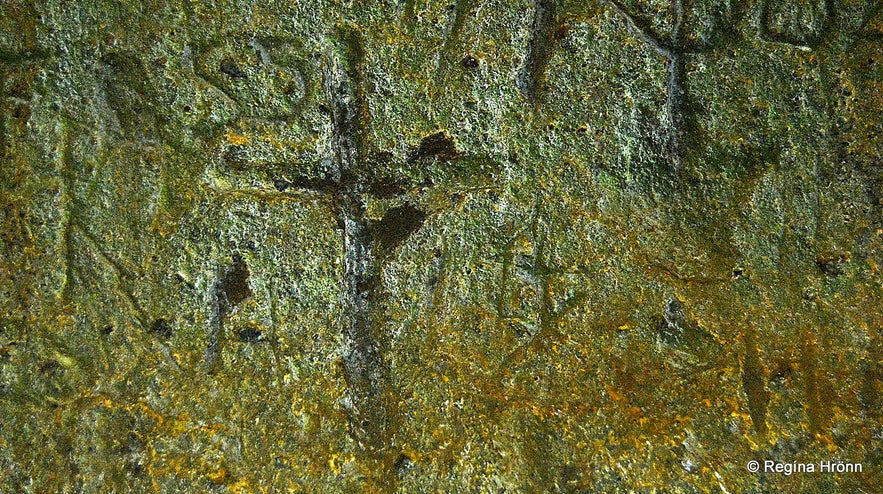 Crosses in the Sönghellir cave
Crosses in the Sönghellir cave
It is not allowed to put any more carvings on the walls of Sönghellir cave as these age-old carvings are important to the history of us Icelanders. Let's please respect that.
Bring a flashlight if you plan on visiting Sönghellir cave, both for exploring the cave and also for shining the light on the wall, which makes it easier for the camera to take photos.
Do not leave the cave without trying to sing in it; after all, it is the Singing Cave!
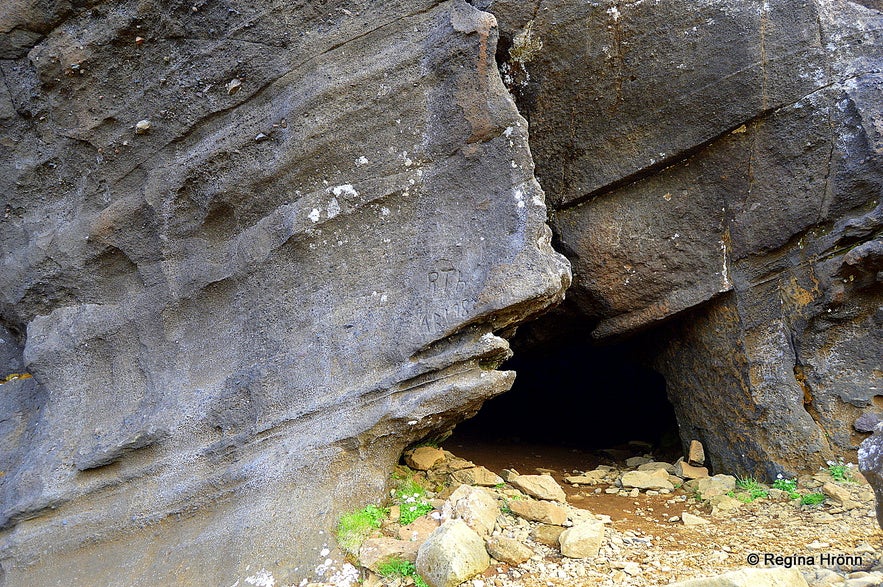 The entrance to the Sönghellir cave
The entrance to the Sönghellir cave
Here you can see the location of Sönghellir cave on the map.
I have written another travel-blog about my favourite caves in Iceland if you want to see more photos of Icelandic caves.
Bárðarlaug - the Pool of Bárður
Bárðarlaug pool
Bárður kept on exploring this area and discovered a pond, i.e. an explosive crater with a lake inside. He took off all of his clothes and took a bath in the pond. Since then it has been called Bárðarlaug pool.
Close to the pool, he found the place where he chose to build a farm and used this explosive crater as his bathing pool; very convenient.
The explosive crater dates back to the close of the last glacial epoch and it seems fitting that the half-troll - half-human used an explosive crater in which to bathe. Just imagine him chilling in Bárðarlaug pool with this beautiful view of Snæfellsjökull glacier.
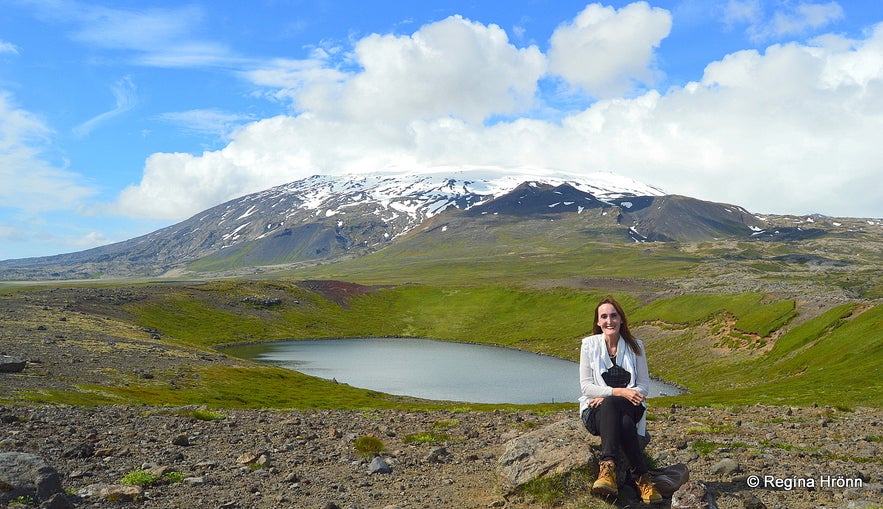 By Bárðarlaug pool
By Bárðarlaug pool
There is an information sign by the road and parking. It is a short, easy 10-minute hike from the road up to this explosive crater. The once warm water is now cold, so don't bathe in it - the pool is a protected natural monument.
Here you can see the location of Bárðarlaug pool on the map.
Laugarbrekka farm
Ruins at Laugabrekka farm
Bárður built his farm at Laugarbrekka and from there he walked up to Bárðarlaug pool, where he bathed.
Here he lived for a while with his 9 daughters (none of whom are mentioned in Íslendingabók). Bárður's daughters were both big and beautiful, the oldest one being Helga.
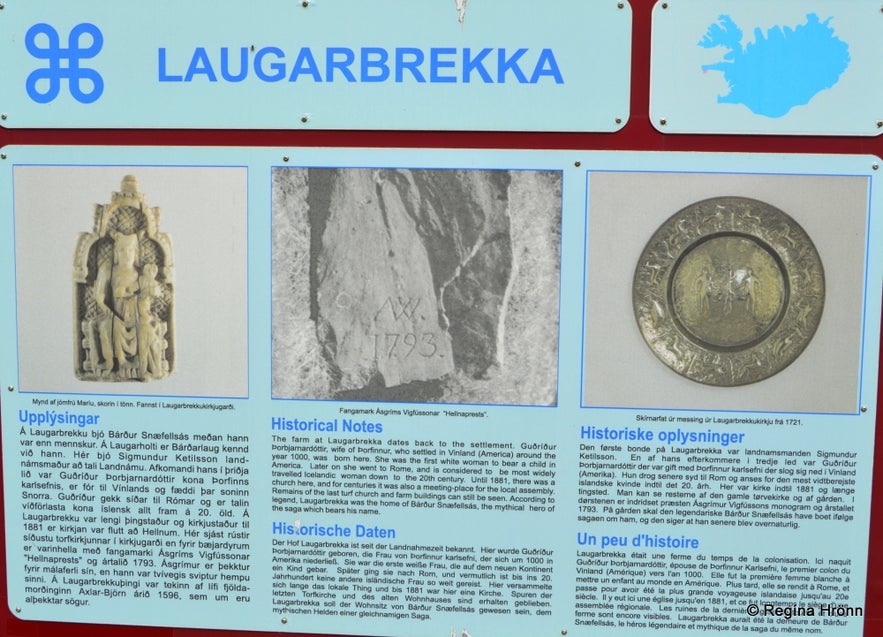 The information sign at Laugarbrekka
The information sign at Laugarbrekka
Bárður lived at Laugarbrekka until he disappeared into Snæfellsjökull glacier after the dreadful incident at Rauðfeldsgjá, which I am going to tell you about later in this travel-blog - and from the glacier, he protects the Snæfellsnes peninsula.
Laugarbrekka is a well-known stop here on the south side of the peninsula, as later on, it was the home of the extraordinary woman, Guðríður Þorbjarnardóttir (980-1050), who was born in 980 here at Laugarbrekka.
At Laugarbrekka - friðlýstar formninjar - preserved relics
In her lifetime she went on 8 sea voyages and travelled twice over the whole of Europe!
It is believed that she was the most widely travelled woman of the Middle Ages.
I have written a special travel-blog about Laugarbrekka and Guðríður: The Historical Laugarbrekka on the Snæfellsnes Peninsula in West Iceland.
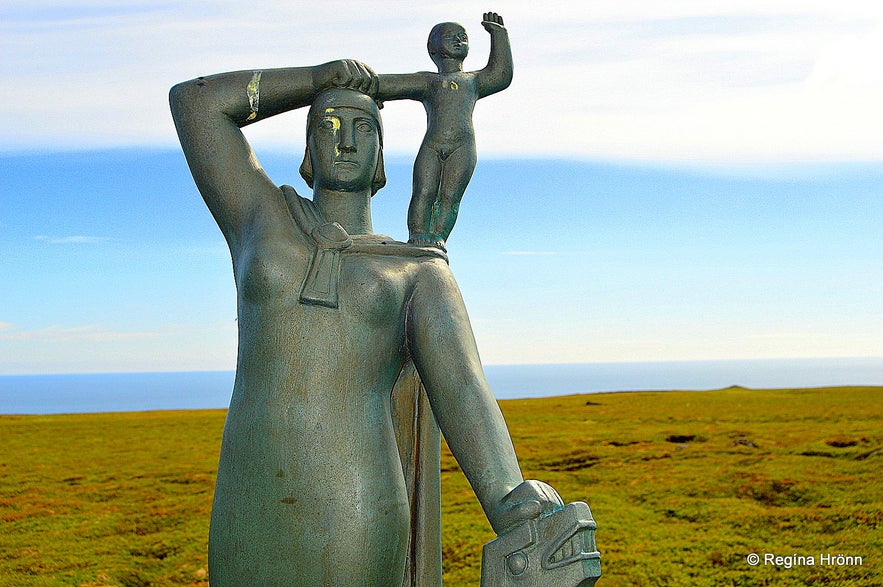 The statue of Guðríður at Laugarbrekka and her son Snorri
The statue of Guðríður at Laugarbrekka and her son Snorri
When Bárður, later on, decided to leave the society of men and find himself a cave to live in somewhere in Snæfellsjökull glacier, he left Laugarbrekka farm to his friend, Sigmundur Ketilsson.
This is what Landmáma - the Book of Settlement (chapter 28) has to say about Sigmundur Ketilsson:
"Sigmundur, son Ketils þistils, þess er numið hafði Þistilsfjörð norður, hann átti Hildigunni. Sigmundur nam land á milli Hellishrauns og Beruvíkurhrauns; hann bjó að Laugarbrekku og er þar heygður. Hann átti þrjá sonu; einn var Einar, er síðan bjó að Laugarbrekku".
Here you can see the location of Laugarbrekka on the map.
Svalþúfa - Þúfubjarg cliff & Svalmöl at Malarrif
Þúfubjarg cliffs
When Bárður sailed to Iceland with him on the ship were many people, amongst them, were Svalur and his wife Þúfa. They are described in the Saga as being difficult people with bad qualities.
On the first night after the arrival of Bárður's ship in Iceland Svalur and Þúfa disappeared from the ship.
They were not to be heard from for a while, but as time went by they breached the peace, but the other settlers refrained from dealing with them because of their sorcery.
Could this be Svalsmöl gravel beach?
A whale beached on Bárður's beach and Svalur, being his usual self, sneaked down to the beach in the middle of the night and started cutting the whale.
As he was busy cutting the whale Bárður came to the beach. Bárður was furious at Svalur and they started wrestling with great force.
 A beached whale
A beached whale
Svalur went berserk which made it difficult for Bárður to wrestle him down, but in the end, Bárður broke Svalur's back and threw him down into the gravel - that is how Svalsmöl gravel beach at Malarrif got its name.
The following night Bárður discovered Þúfa by the whale and killed her in the same way. This is how Þúfubjarg cliff got its name.
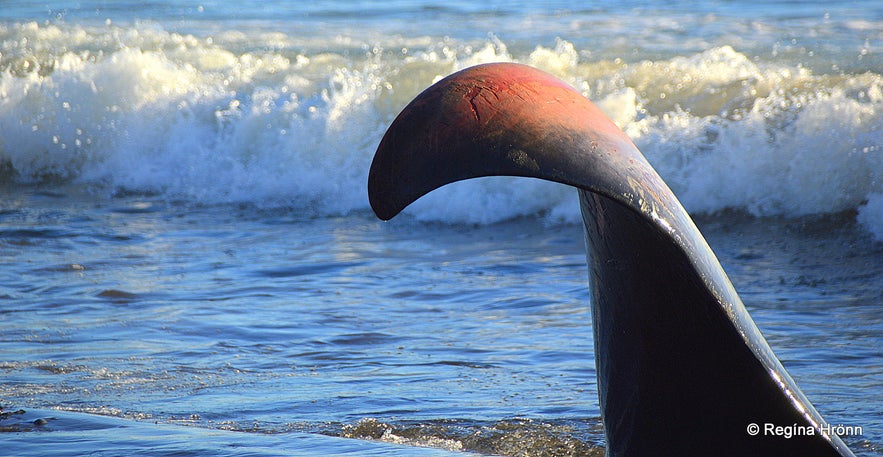 A beached whale
A beached whale
Svalþúfa hill is believed to be inhabited by the elves, and it is forbidden to mow the grass here or misfortune will happen.
Þúfubjarg cliff is 250 meters uphill Svalþúfa and from there you will get a beautiful view of the 2 cliffs of Lóndrangar.
Svalþúfa is the name of the hill and Þúfubjarg is the name of the cliff. This is most likely the eastern part of an old crater.
At Þúfubjarg cliff
I have added much more information in my travel-blog: The Magical Snæfellsnes Peninsula in West Iceland - Part II - Lóndrangar and the Elves and much more
I have seen people struggle with this name when they are looking for Lóndrangar cliffs, not knowing why it says Svalþúfa-Þúfubjarg on the sign. Now you at least know after whom it got its name and why ;)
Here is the location of Svalþúfa-Þúfubjarg on the map.
Rauðfeldsgjá gorge 
Rauðfeldsgjá gorge
Rauðfeldsgjá gorge or Rauðfeldargjá, as it is also called depending on the declension of the male name Rauðfeldur, got its name from a family tragedy that took place here on the south side of the Snæfellsnes peninsula.
Þorkell Rauðfeldsson, the half-brother of Bárður, had two sons with his wife; Sölvi and Rauðfeldur. They were raised at Arnarstapi, but Bárður's 9 daughters were raised at Laugarbrekka farm close by. Bárður's oldest daughter was Helga.
This group of cousins played together vehemently in the wintertime on the ice on the rivers Barnaár or Children's rivers. The male cousins wanted to be in charge as they were stronger, but the female cousins put up a fair fight.
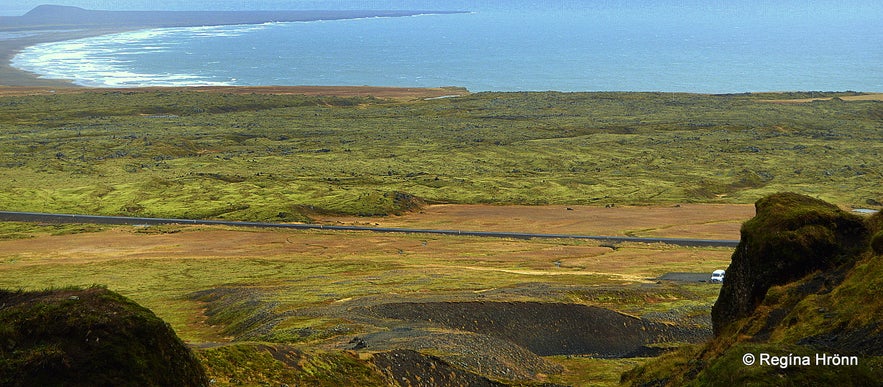
The view from Rauðfeldsgjá
One day the cousins Rauðfeldur and Helga were playing by the sea. The drift ice had arrived and was close to the land on this foggy day. Rauðfeldur pushed Helga onto an iceberg, which drifted towards the drift ice as the wind was strong.
Helga climbed up on the drift ice, which drifted with her out to the open ocean, and in 7 days the sea ice had reached Greenland - with Helga.
Fortunately, Eiríkur rauði - Erik the Red and his son Leifur heppni - Leif the Lucky by now lived in Greenland, but they had left Iceland for Greenland a year earlier. Helga spent the winter with Eiríkur, who knew of her father Bárður.
I am not going to tell you more about what happened to Helga in Greenland, but she got into several adventures.
Inside Rauðfeldsgjá gorge
Once Helga, while in Greenland, got homesick and wrote a poem about all of the places surrounding her home at Laugarbrekka or undir Jökli - beneath the Glacier, as this area is also called. In the poem, she names all of the places that she misses:
"Sæl væra ek,
ef sjá mættak
Búrfell, Bala,
báða Lóndranga,
Aðalþegnshóla
ok Öndvert nes
Heiðarkollu
ok Hreggnasa,
Dritvík ok möl
fyr dyrum fóstra"
meaning:
"I would be happy
if I were to see
Búrfell, Bala,
both of Lóndrangar cliffs
Aðalþegnshóla
and Öndvert nes
Heiðarkolla
and Hreggnasi
Dritvík and gravel
in front of the doors of my foster-father".
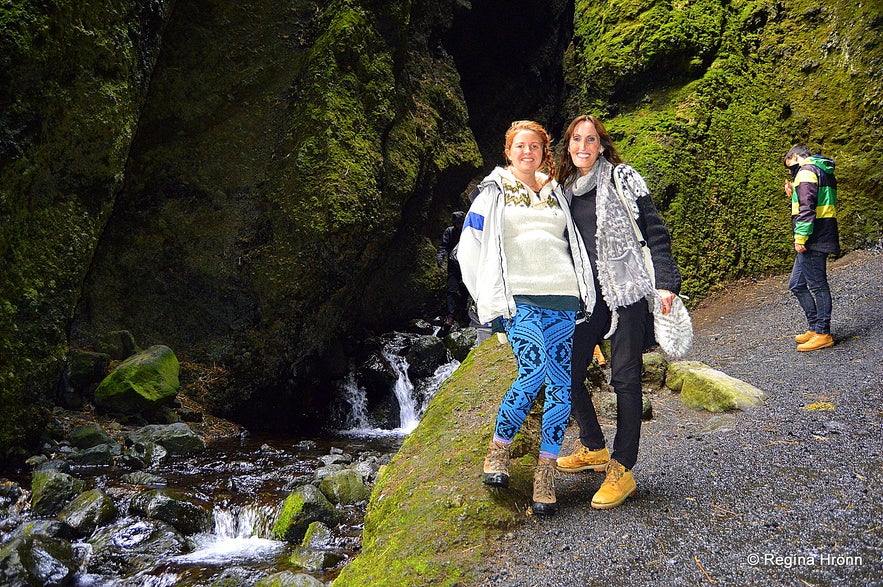
Inside Rauðfeldsgjá gorge with Nanna
The next summer Helga went to Norway with her friend (and lover) Miðfjarðar-Skeggi and spent the winter there. The following year she finally returned to Iceland in the company of Miðfjarðar-Skeggi.
Now, let's look at how Bárður reacted to Helga's disappearance. Helga's sisters had hurried back home to tell their father about what had happened to Helga.
Bárður was livid, jumped up, and stormed to Arnarstapi, where his half-brother and nephews lived. His nephews, who were only 11 and 12 years old at the time, were playing outside but their father was not at home.
Rauðfeldsgjá gorge
Bárður grabbed them and put them under his arms and headed for the mountains. Bárður was so strong that the boys could not defend themselves.
Bárður threw his nephew Rauðfeldur into a large and deep gorge and thus killed him! The gorge got its name from this tragedy and is called Rauðfeldsgjá or Rauðfeldargjá gorge.
Sölvahamar at Arnarstapi
Sölvahamar cliff
The origin of the name of Sölvahamar cliff by Arnarstapi is also to be found in the Saga of Bárður Snæfellsás. Sölvi was the brother of Rauðfeldur and joined his brother in pushing Helga onto the iceberg.
After throwing Sölvi's brother Rauðfeldur into Rauðfeldargjá gorge, out of rage Bárður also threw his other nephew Sölvi from the cliff and broke his skull! By now he had killed both his nephews :(
The settler Sölvi lived at Brenningur, but later moved to Sölvahamar as he thought living at that location was more fruitful.
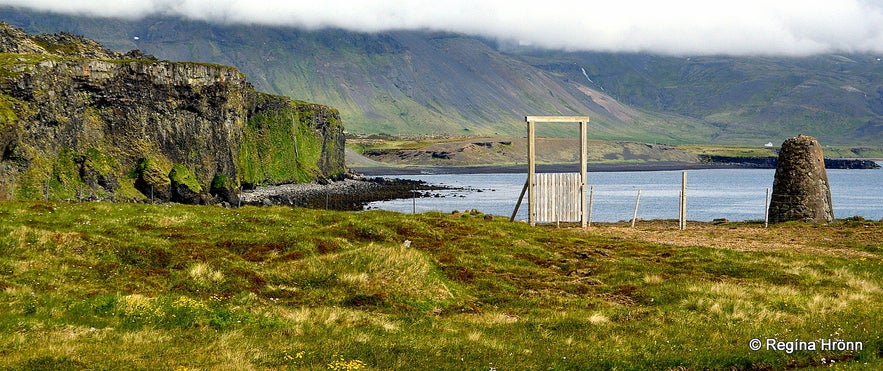
Sölvahamar cliff
This is what is written about Sölvi in Landnámabók - the Book of Settlements chapter 28: "Sölvi hét maður, er nam land milli Hellis og Hraunhafnar. Hann bjó í Brenningi, en síðar á Sölvahamri, því að hann þóttist þar vera gagnsamari."
After killing both of his nephews Bárður paced to Arnarstapi to inform them about what had just happened and returned back to Laugarbakki on foot. His half-brother Þorkell returned back home and got the news of the murder of both his sons.
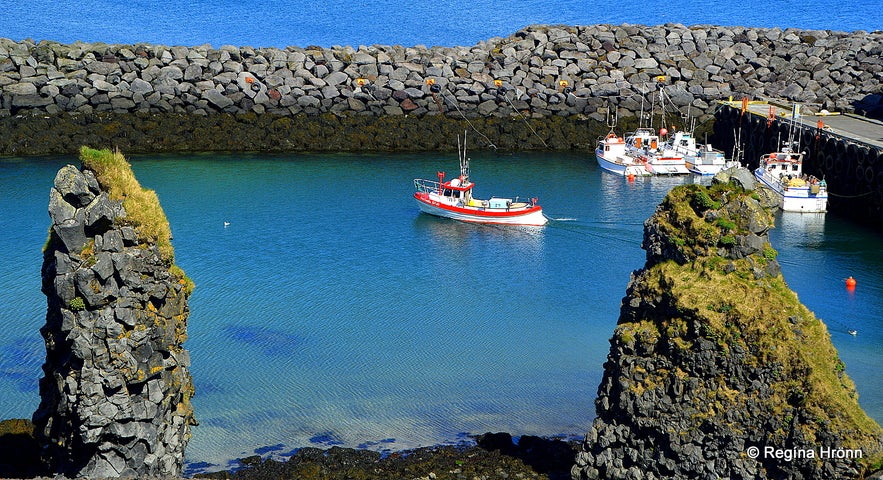
Arnarstapi
He followed his half-brother and they fought intensely. Bárður broke Þorkell's leg and left him on the ground. Þorkell managed to crawl back home and after his leg had healed he left the Snæfellsnes peninsula. What a dreadful family tragedy :(
Bárður became both quiet and hard to deal with after this tragedy - I would say that he must have suffered from PTSD after such an ordeal - his eldest daughter had disappeared on sea ice and he had killed his 2 young nephews and battled with his half-brother.
He decided to leave Laugarbrekka and donated it to his friend Sigmundur, as I mentioned earlier.
 Arnarstapi
Arnarstapi
Bárður left with all his belongings and it is believed that he disappeared into Snæfellsjökull glacier, where he seems to have built a large cave.
He had partly been raised by the giant Dofri in the Dofrafjöll mountains and had lived in a cave with him and Dofri's daughter, so it seems that living in a cave after this ordeal was more to his liking.
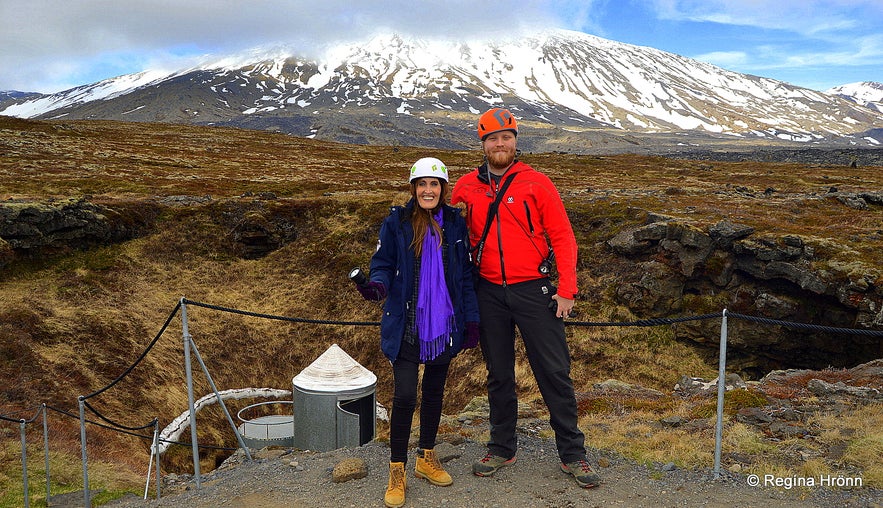
Going into another cave, Vatnshellir - Snæfellsjökull in the background
After Bárður disappeared into the glacier he got the name Bárður Snæfellsás as he was more like a troll and titan than a human being, and people regarded him almost as their protector and called upon him in their hour of need - and he helped many.
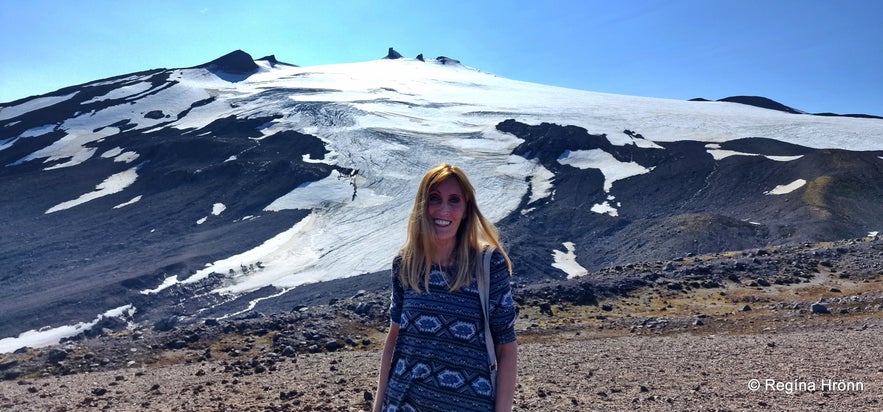 By the foot of Snæfellsjökull glacier
By the foot of Snæfellsjökull glacier
Thus Bárður became known as the Protector of the Snæfellsnes peninsula.
Ingjaldshóll and the settler Ingjaldur Alfarinsson
Ingjaldshólskirkja church and the memorial
According to the 29th chapter of Landnáma - the Book of Settlement - Ingjaldur Alfarinsson settled at Ingjaldshvoll (-hóll).
Ingjaldur was one of the more than 30 people who had accompanied Bárður on his ship to Iceland and following Bárður's advice, he settled at Ingjaldshvoll.
In the 8th chapter of the Saga of Bárður Snæfellsás, you can read about the giantess/sorceress Hetta in Mt. Ennisfjall - this Hetta was very difficult to deal with.
Ingjaldur and Hetta had a disagreement when Hetta started killing Ingjaldur's sheep. Ingjaldur followed her into the mountains and as a negotiation effort, Hetta told him about a rich fishing ground and advised him to go fish there alone. This was a trick on Hetta's behalf as she wanted Ingjaldur dead!
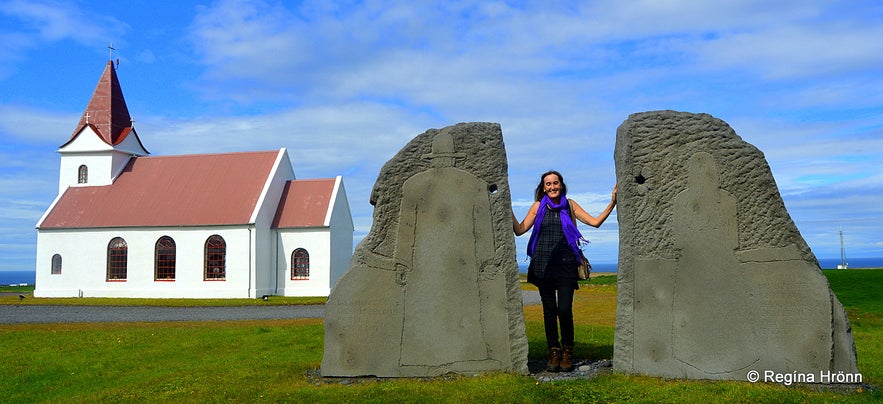
I don't have any photos of the old farm at Ingjaldshóll, so here is another one with me in it ;)
Seeing that Hetta was a giantess, which could apparently also be understood as a sorceress, she conjured up a storm when Ingjaldur was out fishing in the rich fishing grounds to drown him. During the terrible storm, Ingjaldur called upon Bárður Snæfellsás for help.
As Ingjaldur had almost frozen to death a boat approached him - one man was on the boat dressed in a grey cloak - Ingjaldur recognized Bárður Snæfellsás who had come to his rescue.
Bárður said: "Lítt ertu staddur kumpán minn og voru það mikil undur að þú, jafnvitur maður, lést slíka óvætt ginna þig sem Hetta er og far nú á skip með mér ef þú vilt og prófa að þú fáir stýrt en ég mun róa" - meaning: "You are in trouble my friend and I am very surprised that you, as wise as you are, let such a sorceress as Hetta deceive you. Come aboard my boat if you like and try to steer while I row".
Bárður rescued Ingjaldur and brought him to Ingjaldshvoll and revived his almost frozen body. Ingjaldur fully recovered and Bárður returned back to his home in Snæfellsjökull glacier.
Bárðarkista - the Chest of Bárður
Notice the peak or hump on top of Mt. Hreggnasi - it is called Bárðarkista or the Chest of Bárður and is said to be Bárður's chest with his gold and treasures. This is yet another place on the south part of the Snæfellsnes peninsula bearing the name of Bárður Snæfellsás.
Bárður was often seen wearing a grey cloak with a rope around him and he helped many people in need on the peninsula - all of his friends called upon him in their hour of need.
After he disappeared into the glacier his daughters visited him in the cave and sometimes Helga visited him, but Bárður, when hearing that his daughter Helga had returned back to Iceland, went to get her from the married Miðfjarðar-Skeggi.
Helga was discontented with her father and had a hard time as it seems without Miðfjarðar-Skeggi, she couldn't settle down and wandered around.
There are many places in SW-Iceland named after Helga, f.ex. Helgufoss waterfall and Helgustekkur in Grafarvogur suburb in Reykjavík, next to where I lived for 13 years.
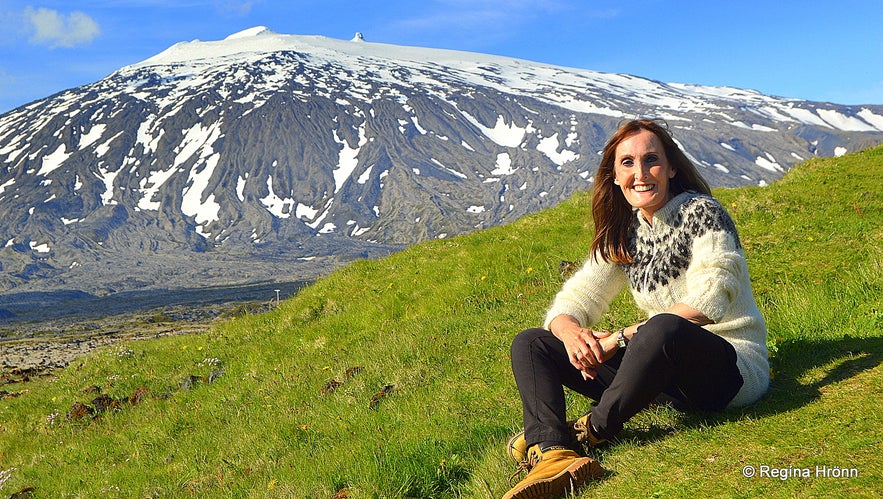
Does Bárður still reside in this glacier?
Bárður and his half-brother Þorkell made up and spent a lot of time together. After disappearing into the glacier Bárður was busy and even had his only son, named Gestur, by a woman named Þórdís, the daughter of Miðfjarðar-Skeggi, with whom he spent one winter.
Helga, the daughter of Bárður, came to Þórdís and offered to raise her half-brother until he was 12 years old, Þórdís had raised him for 1 year and after that, he lived with his father in Snæfellsjökull glacier.
So you see that even after Bárður disappeared into the glacier he lived a colourful life.
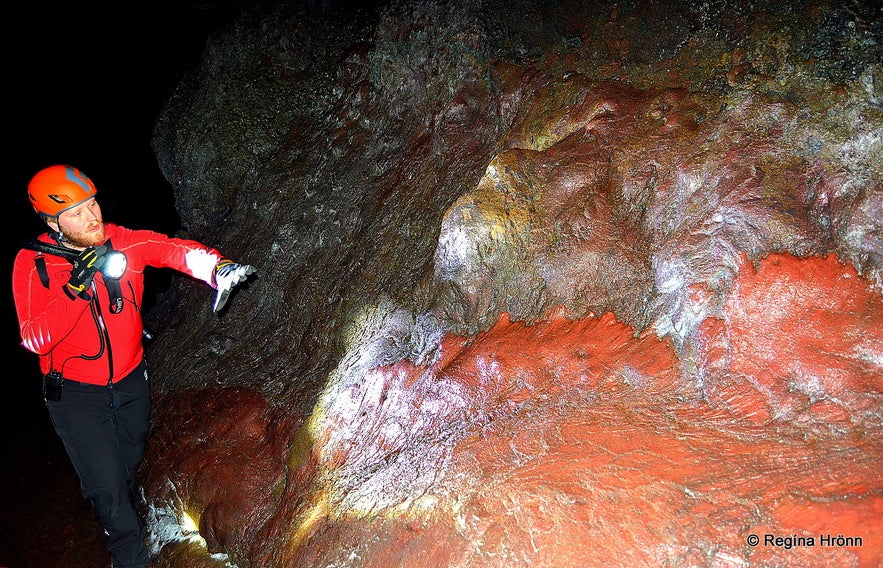 Did Bárður reside in this colourful cave?
Did Bárður reside in this colourful cave?
You can read about Gestur in the Saga of Bárður Snæfellsás, but I want to tell you just one thing. Gestur got Christened and on the night of his Christening, his father Bárður appeared to him in a dream and scolded him for leaving the old gods of his forefathers.
Báður said to his son: "Illa hefir þú gert er þú hefir látið trú þína, þá er langfeðgar þínir hafa haft, og látið kúga þig til siðaskiptis sakir lítilmennsku og fyrir það skaltu missa bæði augu þín." meaning "You have done a bad deed when you abandoned the faith of your ancestors and were bullied into taking on another faith. You are a small-minded man and therefore you will lose both your eyes".
As a punishment for doing so, he would lose both of his eyes - that is a pretty harsh punishment! When Gestur woke up his eyes were hurting so much and exploded on that same day - and Gestur, the only son of Bárður Snæfellsás, died! - Chapter 21.
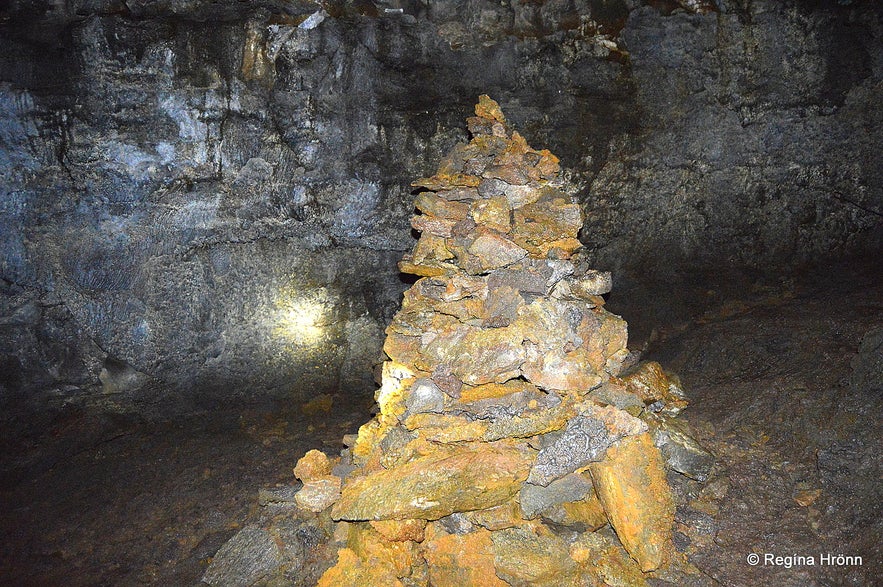 Inside a lava cave in Snæfellsnes
Inside a lava cave in Snæfellsnes
The faith in the protection of Bárður Snæfellsás is still alive and some people adjure Bárður. Bárður is still said to support people and help them.
Psychics talk about seeing and sensing a great spirit in the Snæfellsjökull glacier, who protects the west coast of Iceland and all the air traffic and ships between Europe and North America.
This great spirit is thought to be Bárður Snæfellsás (Dulmagn Snæfellsjökuls, Leiðarljós 1999).
 By the foot of Snæfellsjökull glacier
By the foot of Snæfellsjökull glacier
Bárður sounds like a character from the Lord of the Rings, but J.R.R. Tolkien apparently got some of his ideas from listening to Icelandic folklore when his Icelandic au pair was telling the stories to his children at bedtime.
J.R.R. Tolkien started writing the Lord of the Rings at the time the Icelandic au pair, Arndís - Adda from Bíldudalur in the Westfjords of Iceland, was working for him.
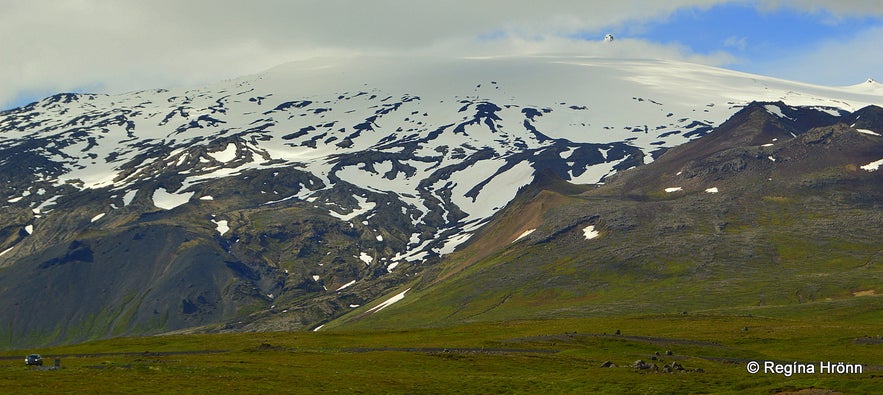
Snæfellsjökull glacier
So now you know the story of Bárður Snæfellsás, who is the Protector of the Snæfellsnes peninsula operating from the glacier. You can read the whole story in the Saga of Bárður Snæfellsás.
There is so much more though and I have written a special travel-blog about the big troll party held by the giantess Hít in Hítardalur valley. She invited all the trolls of Iceland to the party:
The Giantess Hít in Hítardalur Valley and the Party of the Trolls - Icelandic Folklore
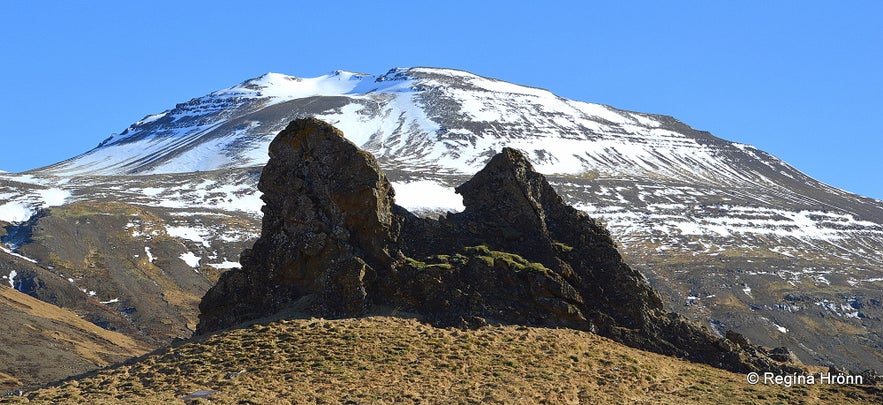 Trolls in Hítardalur valley, some say that these rocks are Bárður and Hít
Trolls in Hítardalur valley, some say that these rocks are Bárður and Hít
And in Ármanssaga hin yngri we can read about the troll games on Hofmannaflöt plain next to Mt. Ármannsfell at Þingvellir in South Iceland, where the half-trolls and strongest men of Iceland competed against each other.
Bárður and Ármann's mother, Svafrlaug, were first cousins and Ármann is the protector of his surroundings much like Bárður is the protector of the Snæfellsnes peninsula. Ármann is much lesser known than Bárður Snæfellsás though.
I have written another travel-blog about Ármann and the troll games on Hofmannaflöt plains: Ármann in Mt. Ármannsfell and the Troll Games on Hofmannaflöt Plains in South Iceland.
With Bárður at Arnarstapi
If you want to read up on the Magical Snæfellsnes Peninsula then I have written an I-V part travel-blog about what there is to see and do on the peninsula:
The Magical Snæfellsnes peninsula - part I
The Magical Snæfellsnes peninsula - part II
The Magical Snæfellsnes peninsula - part III
The Magical Snæfellsnes peninsula - part IV
The Magical Snæfellsnes peninsula - part
Have a lovely time on the beautiful Snæfellsnes peninsula :)
Sources:
Bárðar Saga Snæfellsáss (written in the 14th century)
